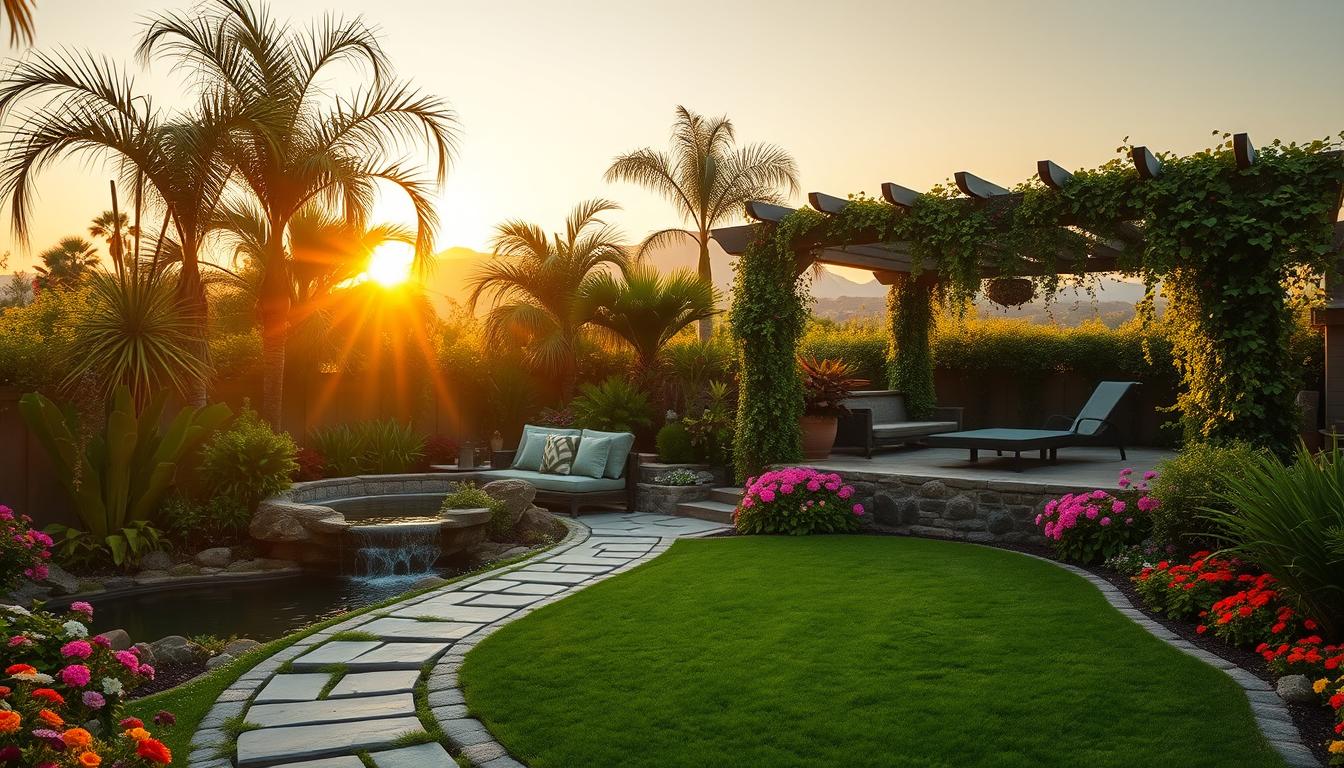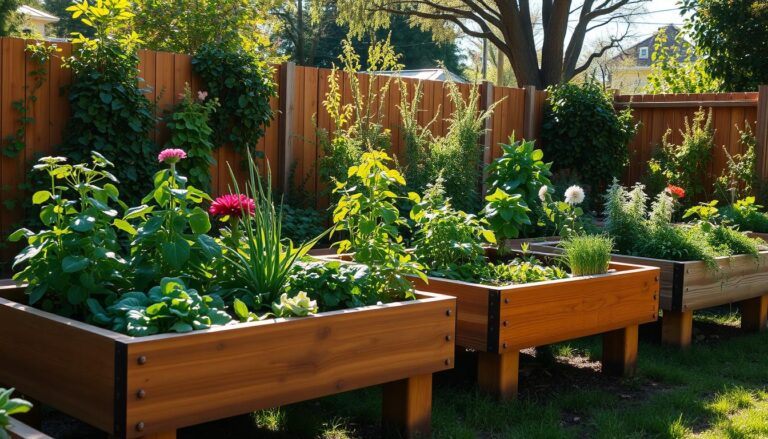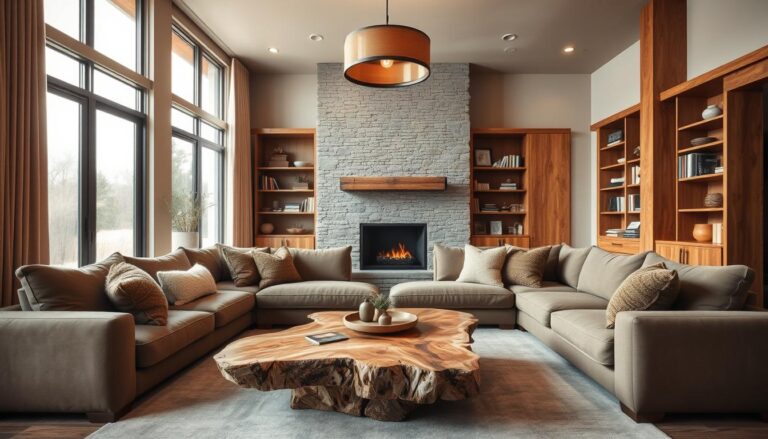Inspiring Backyard Gardening Ideas for a Lush Oasis
This post contains affiliate links, meaning I may receive a small commission if you make a purchase through my links, at no extra cost to you.
Imagine stepping into your own serene escape, where worries fade away. Turning your outdoor area into a lush oasis is simpler than you might think. With inspiring gardening ideas, you can make a space for relaxation, fresh air, and special moments with family and friends.
Think about the possibilities for your perfect retreat. With a bit of creativity, your outdoor area can become a peaceful paradise. It’s the perfect spot for both relaxation and fun. By making your dream come true, you’ll enjoy the beauty of your own backyard oasis.
Key Takeaways
- Create a serene atmosphere with lush greenery and vibrant flowers.
- Incorporate outdoor features that promote relaxation and entertainment.
- Transform your outdoor space into a haven for making memories.
- Discover inspiring gardening ideas to bring your vision to life.
- Design a tranquil paradise that reflects your personal style.
1. The Basics of Backyard Gardening: Getting Started
A beautiful backyard garden starts with understanding the basics of gardening. To create a lush oasis, you need to begin with the fundamentals. According to one expert, “Working with a small backyard is all about taking advantage of every square inch of space.” This emphasizes the importance of getting started with the basics to maximize your space.
Choosing the Right Location
Selecting the right location for your garden is crucial. Most plants require at least 6 hours of direct sunlight per day. Consider the layout of your yard and the amount of shade it receives. If your yard is mostly shaded, you can still grow shade-loving plants.
Observe your yard’s microclimates, as different areas may have varying conditions. For example, a spot near a wall or a fence can be warmer or cooler than other areas. Understanding these microclimates will help you choose the right plants for each location.
Understanding Soil Types
Soil is the foundation of your garden. There are three main types of soil: clay, sand, and loam. Clay soil retains water, sand drains quickly, and loam is a mix of both. You can test your soil type by performing a simple DIY soil test. Knowing your soil type will help you choose the right plants and amendments.
| Soil Type | Characteristics | Best Plants |
|---|---|---|
| Clay | Retains water, dense | Roses, Lavender |
| Sand | Drains quickly, dry | Cacti, Succulents |
| Loam | Balanced, fertile | Most vegetables, flowers |
Essential Tools for Beginners
As a beginner, you’ll need some basic tools to get started. These include a garden fork, trowel, pruning shears, and gardening gloves. Investing in good-quality tools will make gardening easier and more enjoyable.
Start with the essentials and gradually add more tools to your collection as you gain experience. You can find many Garden Design Diy tutorials online to help you create your own gardening tools and accessories.
2. Designing Your Garden: Layout Considerations
Your garden’s layout is the base of your outdoor space. A well-designed garden can make your yard look better and offer a peaceful spot. We’ll look at important things to think about when planning your garden’s layout.
Using Raised Beds for Organization
Raised beds are great for organizing your garden, especially in small spaces. They let you grow many plants in a small area. They also help with drainage and soil quality. Think about using raised beds to make your garden look good and work well. You can add a 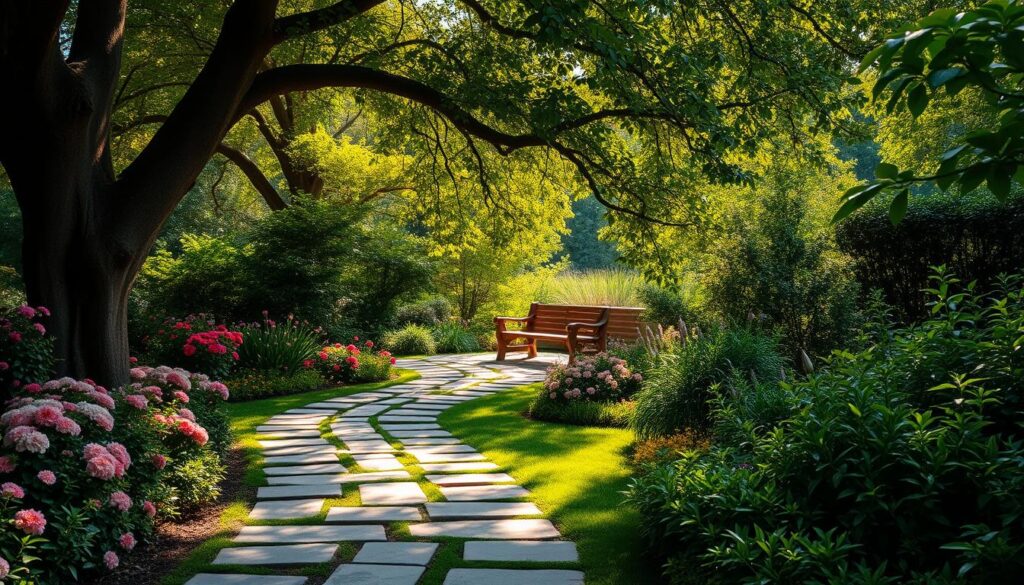
When picking raised beds, think about size and material. You can pick from wood, metal, or composite materials. The size depends on the space you have and the plants you want to grow.
Incorporating Pathways and Seating
Pathways and seating areas are key in garden design. They help you move around your garden easily and enjoy it. Use natural materials like stone or gravel for your pathways. Add seating areas, like benches or patio sets, to make your garden inviting.
When planning your pathways and seating, think about your garden’s flow. You want a natural path that guides visitors. Use curves and angles to make it interesting.
Adding Focal Points with Decor
Decor can make your garden more interesting and create focal points. Use garden ornaments, statues, or other decorations to improve your garden’s look. Lighting can also highlight certain features or create a mood.
When picking decorations, think about your garden’s style and theme. You want everything to match your taste. Feel free to try different things until you find the right mix.
3. Selecting the Perfect Plants for Your Space
A great garden starts with the right plants. Think about plants that need little care and fit your local weather and soil. This makes your garden beautiful and easy to keep up.
Native Plants for Low Maintenance
Native plants are perfect for easy gardening. They love your local weather and soil, so they need less water, pruning, and food. Black-eyed susans and coneflowers are great examples. They also attract butterflies and birds.
For a Diy Garden Projects twist, use a Cinder Block Garden. Cinder blocks can make a raised bed or a wall. They look good with native plants for a simple, yet stunning garden.
| Plant Type | Maintenance Level | Climate Tolerance |
|---|---|---|
| Native Plants | Low | High |
| Non-Native Plants | High | Low |
Selecting a Color Palette
Think about the look you want for your garden. You can go for one color, mix colors, or use bright ones. Look at your surroundings to pick the right colors.
A Garden Sink adds beauty and sound to your garden. It’s a great spot for a peaceful vibe.

Edible Plants to Enhance Your Garden
Adding edible plants is fun and rewarding. Try growing fruits, veggies, and herbs like tomatoes, lettuce, and basil. You’ll have fresh food and a lively garden.
Choose plants that fit your climate, soil, and care level. With some planning, you’ll have a garden full of food and beauty.
4. Creating a Sustainable Garden: Eco-Friendly Tips
Creating a beautiful backyard garden is more than just picking plants. It’s about being eco-friendly. This way, you can help the planet while enjoying a lush garden. Here are some easy tips to make your garden sustainable.
Composting for Nutrient-Rich Soil
Composting is a smart way to cut down on waste and make your soil better. It turns food scraps and leaves into a natural fertilizer. This helps your plants grow strong.
To compost, you need a bin or pile. Composting reduces waste and makes your soil better for plants. It also helps the soil hold water and supports good bacteria.
A good compost pile is a treasure for your garden. It gives your plants the nutrients they need. Try composting to make your garden healthier and more sustainable.
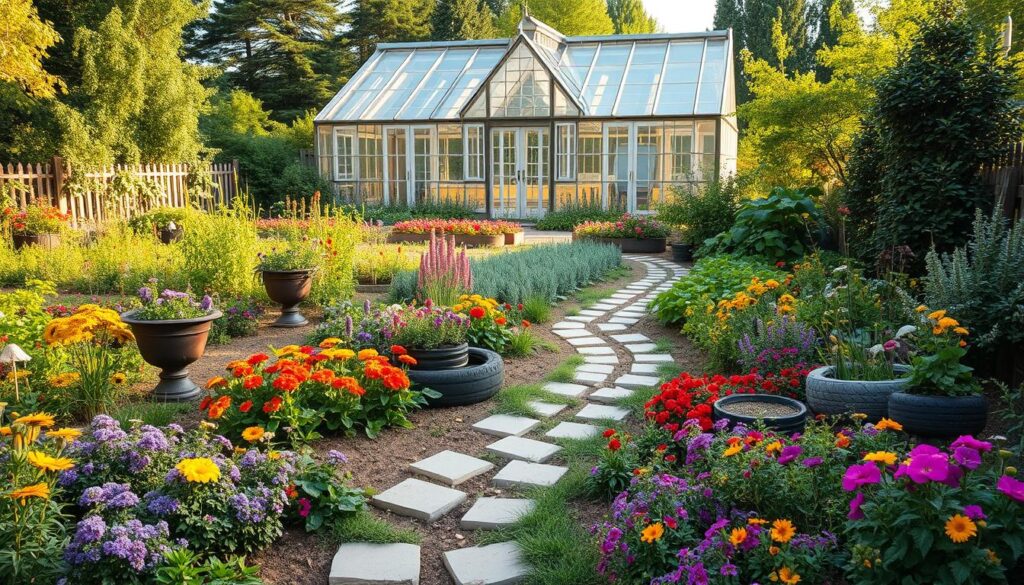
Water Conservation Techniques
Water is key for a sustainable garden, especially where water is scarce. Using rainwater harvesting systems is a smart move. These systems collect rainwater for your plants.
Drip irrigation and soaker hoses also save water. They deliver water right to the roots, cutting down on evaporation and runoff. Using drought-tolerant plants is another way to save water. These plants need less care and water.
Adding mulch or soil coverings helps keep moisture in the soil. It also stops weeds from growing. These steps help your garden use less water.
Beneficial Insects for Pest Control
Bees, butterflies, and ladybugs are important for a healthy garden. They help control pests without chemicals. To attract them, plant a variety of flowers and herbs.
Building a DIY backyard waterfall or pond attracts these insects. It also helps local wildlife. Using native plants and materials makes your garden better for the environment.
5. Incorporating Water Features: Tranquility in the Garden
Turn your backyard into a peaceful oasis with water features. The soft sound of water flowing can make your garden a calm place. It’s ideal for relaxing and unwinding.
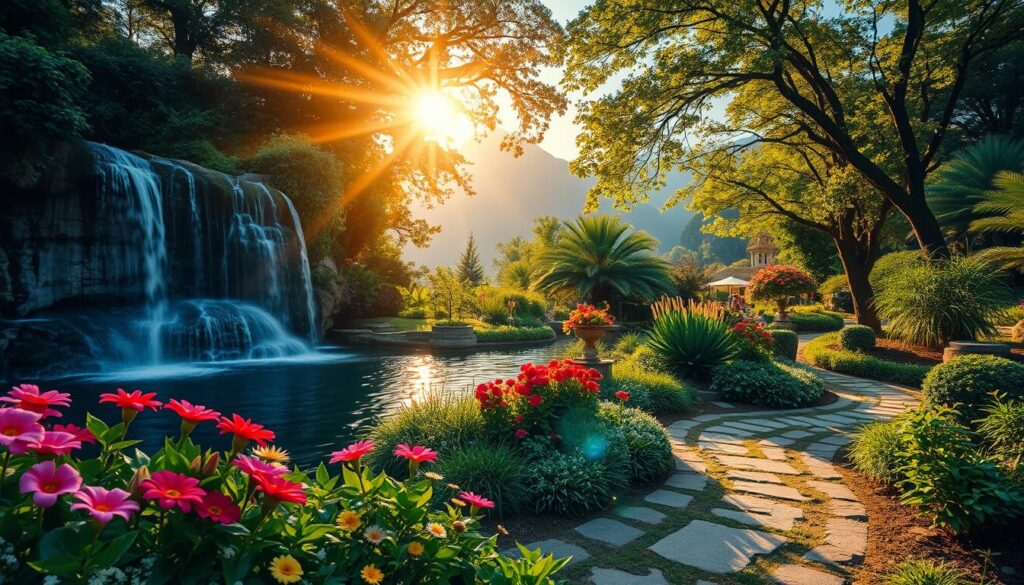
DIY Fountain Ideas
Making a DIY fountain is a fun project. You can use stone, glass, or metal to make it unique. Start with a simple fountain using a kit or an old container like a pot.
To make it special, add:
- Decorative stones or pebbles
- Water plants, like water lilies or cattails
- A small pump for movement and sound
Small Ponds for Wildlife
A small pond is a wildlife haven. It attracts birds, bees, and butterflies. Think about the pond’s size, depth, and plants to support the wildlife you want.
| Feature | Benefit |
|---|---|
| Water Plants | Oxygenate the water and provide shelter for aquatic life |
| Rocks and Boulders | Provide habitat for insects and microorganisms |
| Shallow Areas | Allow birds and other wildlife to access the water |
Benefits of a Water Garden
A water garden, like a pond or fountain, offers many benefits. It creates a peaceful spot, attracts wildlife, and lets you explore gardening and design.
Key benefits include:
- Creating a habitat for aquatic plants and animals
- Providing a soothing and calming environment
- Enhancing your garden’s look
Adding a water feature makes your garden a serene and peaceful oasis. It’s perfect for relaxation and enjoyment.
6. Backyard Gardening for Small Spaces: Maximizing Efficiency
You can make a beautiful garden in a small backyard. The trick is to use your space wisely. Creative solutions can make your garden look great and keep it healthy.
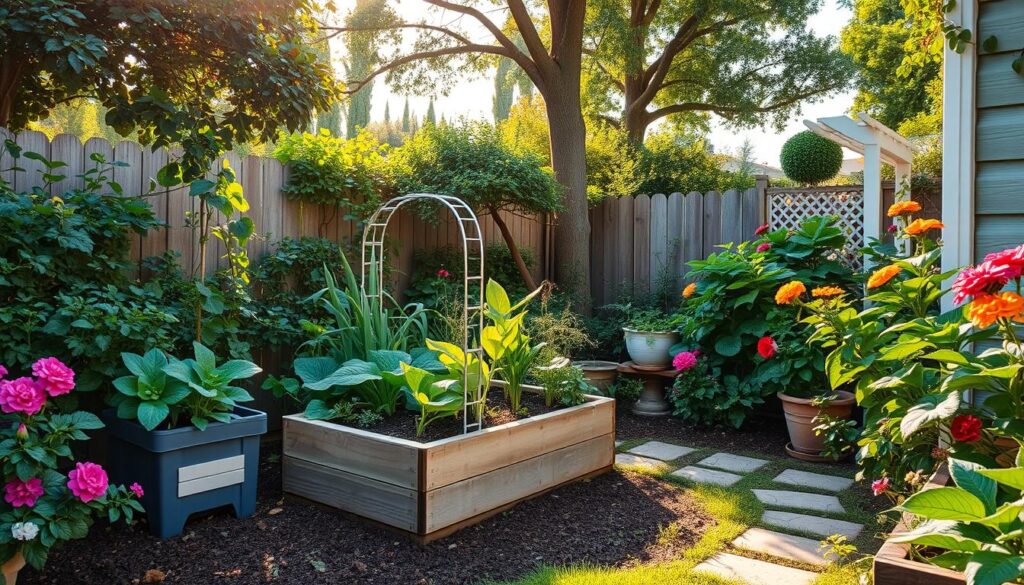
Vertical Gardening Solutions
Using vertical space is a smart way to garden in a small area. Trellises, arbors, and wall planters can increase your planting area. They add beauty and make the most of your space.
Start by checking your backyard’s sunlight. Pick plants that like the light you have. Then, find a vertical gardening system that fits your needs and budget. With some creativity, a small corner can become a lush vertical garden.
Container Gardening Basics
Container gardening is great for small spaces. It lets you grow plants in pots instead of the ground. This method gives you control over the soil and drainage, and you can move plants easily.
For a thriving container garden, choose plants that do well in pots. Use a good potting mix that holds moisture but drains excess water. With the right care, container gardens can be as lively as any other garden.
Window Boxes and Balconies
Window boxes and balconies are perfect for tiny spaces. Window boxes can be hung under windows or on railings. They’re great for growing flowers, herbs, or small veggies. Balconies can also be turned into mini-gardens with the right plants and containers.
When gardening on a balcony or in window boxes, pick plants that handle wind and sun. Mix flowers and foliage for interest. Make sure containers are secure to avoid wind damage.
“Gardening is a love affair with the earth, a way of nurturing and being nurtured in return.” –
By using these strategies, you can have a beautiful garden in even the smallest backyard. Whether it’s a tiny patio, a narrow balcony, or a small yard, there are many ways to make the most of your space and enjoy gardening.
7. Seasonal Gardening: What to Plant When
As seasons change, your garden needs adjust. Knowing the seasonal cycle is key for a thriving garden. It’s about Home Gardening Ideas and Garden Design Diy that lasts all year.
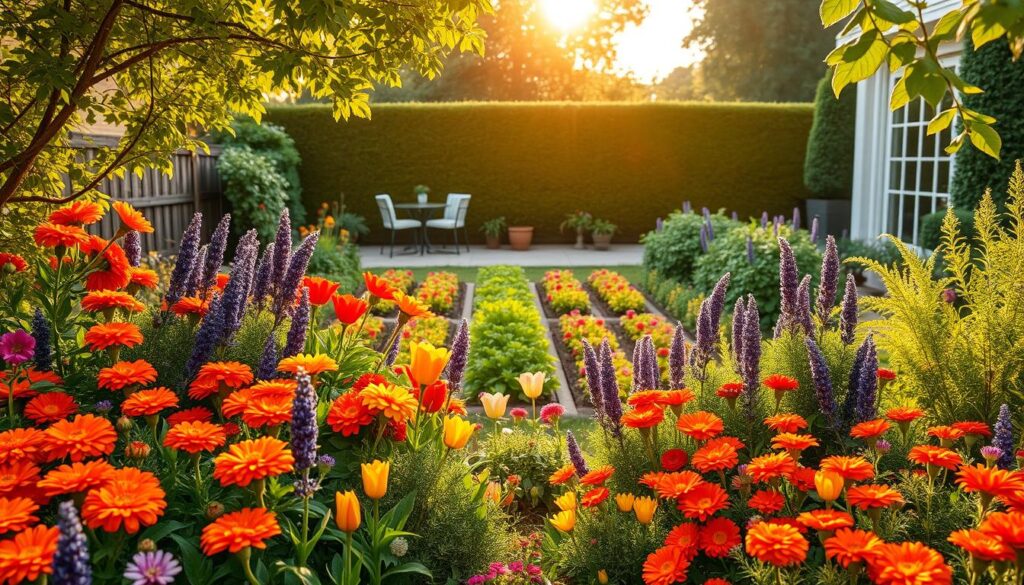
Spring Planting Essentials
Spring is for growth and renewal. Start with cool-season crops like lettuce and peas. They do well in spring’s cool and can be picked before summer.
For color, plant tulips and daffodils. They add beauty and are a great Garden Design Diy touch.
Before planting, prepare your soil. Add compost to enrich it and improve drainage. This helps your plants grow strong.
Summer Garden Maintenance
Summer is warm and long, perfect for many plants. But, it also means fighting drought and heat. Water deeply but less often to encourage deep roots. Mulch to keep moisture in and weeds out.
Check your garden for pests and diseases. Use natural methods to keep it healthy. This keeps your garden looking good.
Preparing Your Garden for Fall
As summer ends, prepare for fall. Clean up your garden and add compost to the soil. This improves its health and fertility.
Plant cool-season crops like broccoli and carrots. Fall is also great for planting trees and shrubs. The cooler weather and more moisture are perfect for them.
8. Attracting Wildlife: Making Your Garden a Habitat
Turning your backyard into a wildlife haven is rewarding. By adding features that draw birds, butterflies, and other creatures, you make your outdoor space beautiful and lively.
Birdhouses and Feeders
Installing birdhouses and feeders is a simple way to welcome wildlife. Birdhouses offer a safe place for birds to nest and raise their young. Feeders provide a quick food source. Choose designs that fit the needs of the birds you want to attract.
For instance, a birdhouse with a roof keeps nests dry. A feeder with a weight-activated perch keeps out big birds and squirrels. This way, you can attract many bird species to your garden.
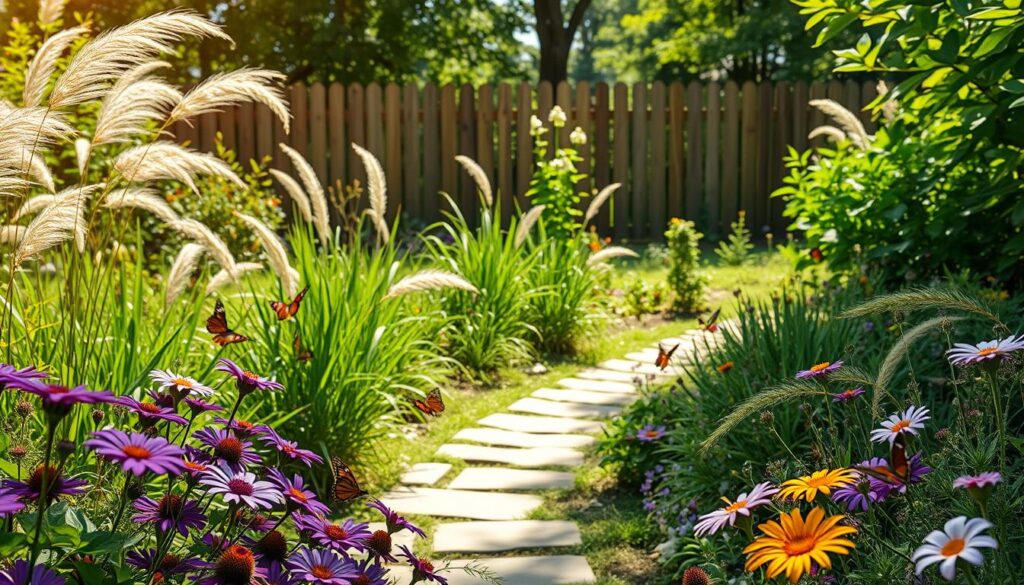
Creating Butterfly Gardens
A butterfly garden is a lovely way to draw these creatures to your yard. To make a butterfly garden, mix nectar-rich flowers, host plants, and sunny spots.
Flowers like Butterfly Bush, Lantana, and Zinnia attract butterflies. Host plants like Milkweed and Dill feed caterpillars. Sunny spots help butterflies warm up.
| Butterfly-Friendly Plants | Nectar-Rich | Host Plants |
|---|---|---|
| Butterfly Bush | Yes | No |
| Milkweed | No | Yes |
| Lantana | Yes | No |
Understanding Pollinator-Friendly Plants
Adding pollinator-friendly plants to your garden helps bees too. Plants like Sunflowers, Coneflowers, and Herbs attract pollinators.
“By incorporating a mix of pollinator-friendly plants, you can create a haven for local wildlife and support the health of your garden ecosystem.”
Choose native plants for your garden. They fit your local climate and soil well. This creates a low-maintenance, thriving ecosystem.
9. Gardening with Kids: Fun and Educational Activities
Gardening with kids is both fun and educational. It teaches them about nature, responsibility, and caring for living things. It’s a great way to create lasting memories and foster a love for the outdoors.
Simple Projects for Young Gardeners
Starting with simple projects keeps young gardeners interested. A Cinder Block Garden is a great idea. Kids can plant easy-to-grow plants like succulents or herbs. This introduces them to DIY projects and gardening basics.
Letting kids create their own mini-gardens in containers is also fun. They can pick the plants, decorate the pots, and care for their gardens. This boosts their creativity and teaches them about plant life cycles.
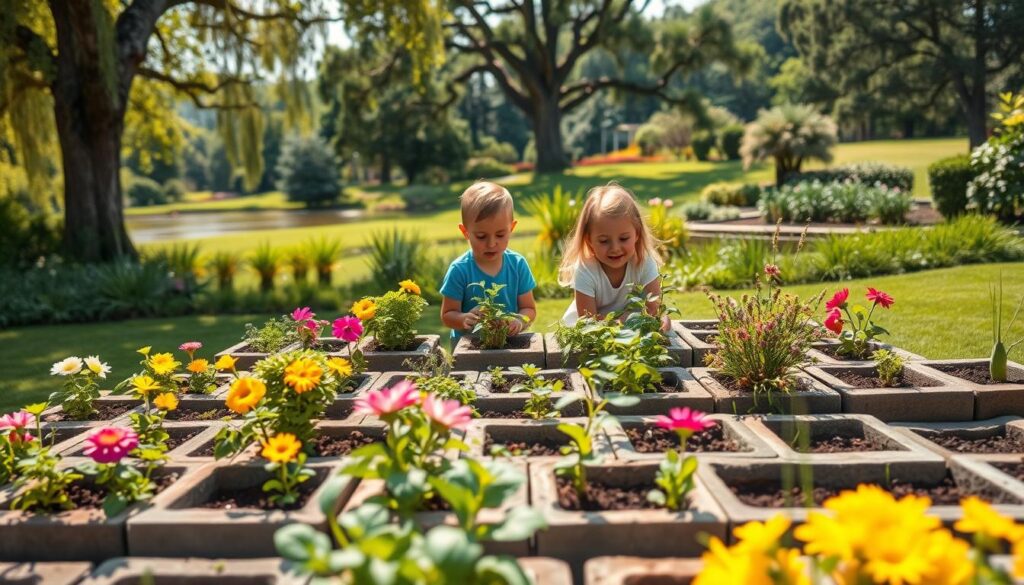
Teaching Responsibility Through Gardening
Gardening teaches kids about responsibility. Assigning tasks like watering, weeding, or harvesting helps them understand the importance of caring for plants. This lesson can apply to other areas of their lives.
“The garden is a love song, a duet between a human being and Mother Nature.” – Jeff Cox
As kids garden, they learn valuable lessons about nurturing and caring for the environment. This not only fosters responsibility but also deepens their appreciation for nature.
Family Gardening Days
Setting aside family gardening days is a great way to spend time together. You can plant new flowers or vegetables, maintain the garden, or simply enjoy your hard work. These days help you bond and create lasting memories.
| Activity | Age Group | Learning Outcome |
|---|---|---|
| Planting a Cinder Block Garden | 6-12 years | DIY skills, plant care |
| Creating Mini-Gardens | 4-10 years | Creativity, plant lifecycle |
| Gardening Tasks | 5-15 years | Responsibility, nurturing |
By making gardening a part of your family’s routine, you can create a fun and educational experience. Whether it’s through simple projects, teaching responsibility, or enjoying family gardening days, there are many ways to make gardening rewarding for everyone.
10. Personalizing Your Backyard Oasis: Decorative Touches
As you finish your backyard gardening project, think about adding decorative touches. A well-designed backyard can become your dream spot, a secret garden for relaxation and nature enjoyment.
Outdoor lighting can make your garden feel welcoming. Use solar-powered lights or string lights for a warm evening glow. A Garden Walkway with soft lighting adds magic to your space.
Outdoor Lighting Ideas
Weather-resistant textiles and outdoor lighting create a magical feel. Fairy lights or lanterns along paths or around seats make cozy spots.
Garden Art and Statues
Garden art and statues bring personality to your backyard. Pick pieces that match your style and the garden’s natural look.
Themed Gardening Concepts
Try a themed garden, like tropical or Mediterranean, for interest and uniqueness. These touches can make your backyard a dream oasis.
FAQ
What are some inspiring backyard gardening ideas for creating a lush oasis?
Start with a garden walkway or a dish garden. DIY projects can also be fun. Yard garden ideas and recycled concepts offer unique inspiration.
How do I choose the right location for my backyard garden?
Look for a spot with good sunlight and soil. Knowing your soil type is key for a thriving garden.
What are some eco-friendly practices I can implement in my backyard garden?
Begin with composting and water conservation. Beneficial insects can control pests. These practices are good for the planet and your garden.
How can I incorporate water features into my backyard garden?
Think about a DIY fountain or a small pond. Water gardens attract birds and butterflies, adding peace to your space.
What are some tips for gardening in small backyards?
Try vertical or container gardening. Use window boxes and balconies to save space. These methods make small areas beautiful.
How can I make my garden a habitat for wildlife?
Install birdhouses and feeders. Create butterfly gardens with pollinator-friendly plants. This attracts wildlife and boosts biodiversity.
What are some fun and educational gardening activities for kids?
Start with simple projects and teach gardening responsibility. Family gardening days are great for learning and fun.
How can I personalize my backyard oasis with decorative touches?
Use outdoor lighting and garden art for a unique feel. Themed gardens reflect your style, making your space inviting.

